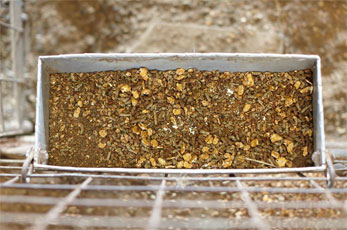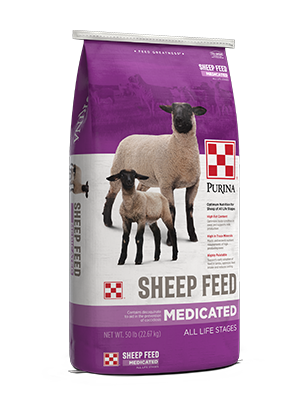
Creep Feeding Lambs
Wellness : Nutrition
Getting young lambs off to a good start sets the table for the potential for a healthy, fast growing, profitable lamb. Creep feeding young lambs provides an opportunity to get lambs started on feed at a much younger age. These lambs then have the potential for optimal weaning weights and can have added bloom and finish.
Lambs that have been fed lamb creep feed rations often experience less stress at weaning as they are used to being fed. Minimizing stress at weaning can positively impact health and performance.
Here are some tips for successfully creep feeding your lambs:
A lamb creep pen should be set up to allow the lambs continuous access to fresh creep feed and a clean and dry environment. The creep gate should be adjusted to ensure access for the lambs but prevent the ewes from gaining access to the creep pen and lamb creep feeder. The creep area should be large enough for several lambs to eat at one time.
A heat lamp or light is often used in colder climates to encourage lambs to find the creep pen. The creep pen and feeder should be setup and available shortly after the ewes and lambs are let out of the lambing pens. The young lambs will soon find that the clean, dry, well-lit creep pen is good place to find feed. Lambs will often explore the creep pen or even nibble on hay or grain in the creep pen as early as 5-7 days of age. However, most lambs will not eat much creep feed until 4-5 weeks of age.Choosing the best creep feed for lambs
A lamb creep feed ration should be between 15-20 percent crude protein, 2-5.5 percent fat and a 2:1 calcium-to-phosphorus ratio. The specific feed that works best will be determined by the genetic make-up of the sheep and the intended market. For example, purebred breeders may like a 20 percent creep pellet for added growth. Club Lamb producers like added fat to produce bloomier lambs at sale time. Some producers like the consistency of feeding a 16 percent to both the ewes and lambs and through the lambs’ grower phase.
Lamb creep feeds need to contain something to help control or prevent coccidiosis in lambs. Both Decoquinate (trade name, Deccox) and lasalocid (trade name, Bovatec) are approved for prevention of coccidia in sheep. A Veterinary Feed Directive (VFD) is not required for these products.
A smaller pellet is currently the most popular choice for creep feeding lambs. The smaller pellet is preferred by the younger lambs and prevents the sorting that is often found in a texturized or mixed feed. Some producers will make their own lamb creep feed rations on farm. The correct sheep feed pellets, maintaining consistent particle size and too many fines are all challenges with on-farm mixing.
Lambs that have been fed lamb creep feed rations often experience less stress at weaning as they are used to being fed. Minimizing stress at weaning can positively impact health and performance.
Here are some tips for successfully creep feeding your lambs:
Lamb creep pen
A creep pen is designed for young lambs to have access to additional feed concentrates separate from their mothers and other mature sheep.A lamb creep pen should be set up to allow the lambs continuous access to fresh creep feed and a clean and dry environment. The creep gate should be adjusted to ensure access for the lambs but prevent the ewes from gaining access to the creep pen and lamb creep feeder. The creep area should be large enough for several lambs to eat at one time.
A heat lamp or light is often used in colder climates to encourage lambs to find the creep pen. The creep pen and feeder should be setup and available shortly after the ewes and lambs are let out of the lambing pens. The young lambs will soon find that the clean, dry, well-lit creep pen is good place to find feed. Lambs will often explore the creep pen or even nibble on hay or grain in the creep pen as early as 5-7 days of age. However, most lambs will not eat much creep feed until 4-5 weeks of age.
Lamb creep feeders
Whether using a self-feeder or a handfeeding, the lamb creep feeders need to be clean. Lambs won’t eat out of a feeder that is dirty or wet. Make sure the lamb creep feeder is free from manure, dirt, straw and excessive moisture. Most sheep breeders will keep feed in the creep feeder at all times. This ensures every lamb will have access to feed every time it goes in the creep pen. Many producers also like to keep good fine stemmed hay available in the creep pen.Choosing the best creep feed for lambs
A lamb creep feed ration should be between 15-20 percent crude protein, 2-5.5 percent fat and a 2:1 calcium-to-phosphorus ratio. The specific feed that works best will be determined by the genetic make-up of the sheep and the intended market. For example, purebred breeders may like a 20 percent creep pellet for added growth. Club Lamb producers like added fat to produce bloomier lambs at sale time. Some producers like the consistency of feeding a 16 percent to both the ewes and lambs and through the lambs’ grower phase.Lamb creep feeds need to contain something to help control or prevent coccidiosis in lambs. Both Decoquinate (trade name, Deccox) and lasalocid (trade name, Bovatec) are approved for prevention of coccidia in sheep. A Veterinary Feed Directive (VFD) is not required for these products.
A smaller pellet is currently the most popular choice for creep feeding lambs. The smaller pellet is preferred by the younger lambs and prevents the sorting that is often found in a texturized or mixed feed. Some producers will make their own lamb creep feed rations on farm. The correct sheep feed pellets, maintaining consistent particle size and too many fines are all challenges with on-farm mixing.




.png?width=300&height=430&ext=.png)
.png?width=300&height=430&ext=.png)